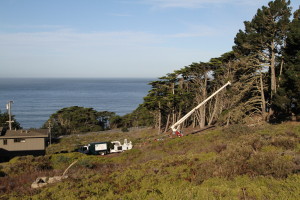It’s almost impossible to miss Sutro Tower, the lanky broadcast antenna that looms 977 feet above the summit of one of San Francisco’s tallest hills, itself over 900 feet tall. However, few people know that underneath that landmark sit 61 acres of open space, rich in history but until recently nearly inaccessible, with trails buried in a mass of invasive Himalayan blackberry and cape ivy.
Now, thanks to a partnership between several local groups and the University of California-San Francisco, volunteers are converging on this urban open space to make way for hikers and native plants. In the process, they’ve made discoveries both historic and natural, and the mountain is once again becoming a destination in bloom. It is, as volunteer Hank Magnuski sees it, “a little wilderness right here in the city.”
The mountain is named after onetime San Francisco mayor Adolph Sutro, a Russian-born immigrant who made his riches mining silver. In the late 1800s Sutro owned land from present-day Mount Sutro to Mount Davidson and south to Ocean Avenue. He planted thousands of eucalyptus, pines, ash, and cypress on this rancho in what became known as “Sutro’s Forest.” Unfortunately, the eucalyptus—planted to provide shelter for the smaller trees—quickly crowded out the other species. They still dominate the landscape. During the Cold War, the mountain was home to a Nike radar site and the public was discouraged from visiting. After the military departed, UCSF took over the land.
The university was inspired to undertake restoration in part by longtime residents such as Craig Dawson, who grew up exploring the mountain. Dawson and the Mount Sutro Stewards, which he co-founded, worked with UCSF to craft a plan to increase biodiversity and improve access. “There was a lot of mystery and attraction to this open space,” says Dawson. “We wanted to see it come alive again.”
Progress is necessarily incremental: The stewards select a several-acre site for restoration. Volunteers clear nonnatives from the understory and then plant natives grown at the Presidio Nursery from local seed. Meanwhile, volunteer professional gardeners from the Gardeners’ Guild cull 10 percent of the mountain’s eucalyptus each year. The long-term goal is to create an expanding patchwork of native habitats on the mountain. The first such “demonstration meadow” blooms atop the mountain with some 1,500 native plants now flourishing, thanks to funding by the Rotary Club of San Francisco.
- The iconic Sutro Tower rises just south of 61 acres of openspace, where the Mount Sutro Stewards are restoring native habitat.Photo by Todd Lappin.
Trail work can prove eventful. In 2006, volunteers set out to survey a new route to the summit meadow—up a steep slope covered with impenetrable blackberry brambles. They stopped along a flat spot to catch their breath, and quickly realized that the ledge kept going, traversing the slope. They had discovered an historic trail, buttressed by well-constructed rock retaining walls, wide enough for travelers on horseback. The trail likely dates back more than a century. That same day, along the same trail, botanist Jake Sigg discovered blooming fairy bells, a plant listed as resident here in the 1950s but thought to have vanished from the city.
Thanks to volunteer efforts from the Palo Alto-based nonprofit Trails Center, the “Historic Trail” is now open to the public. “After all that clearing and excavation, we are discovering that the fairy bells thrive along the pathways,” Dawson says. “The lack of competition from ivy and blackberry encourages [their] growth.”
The Historic Trail wends around the mountain through the cool eucalyptus forest and the dense understory of leather ferns and mugwort. Near the summit, the trees thin and the smell of damp earth subsides. Gravel footpaths lead to a sunny opening, the newly cleared San Francisco Rotary Meadow, where purple salvia and Pacific wax myrtle thrive, attracting both songbirds and butterflies. The meadow is flanked by eucalyptus that obstruct the expected panorama, but the trees do insulate the site from the urban chatter below. Instead you hear branches creaking in the breeze and the low hum of bumblebees on ceanothus. In one of our nation’s most densely populated cities, a meadow—the first of many on Mount Sutro—thrives.
Trail work days are on the first Saturday of every month, rain or shine. For more information, visit www.natureinthecity.org/mtsutro.

.jpg)




